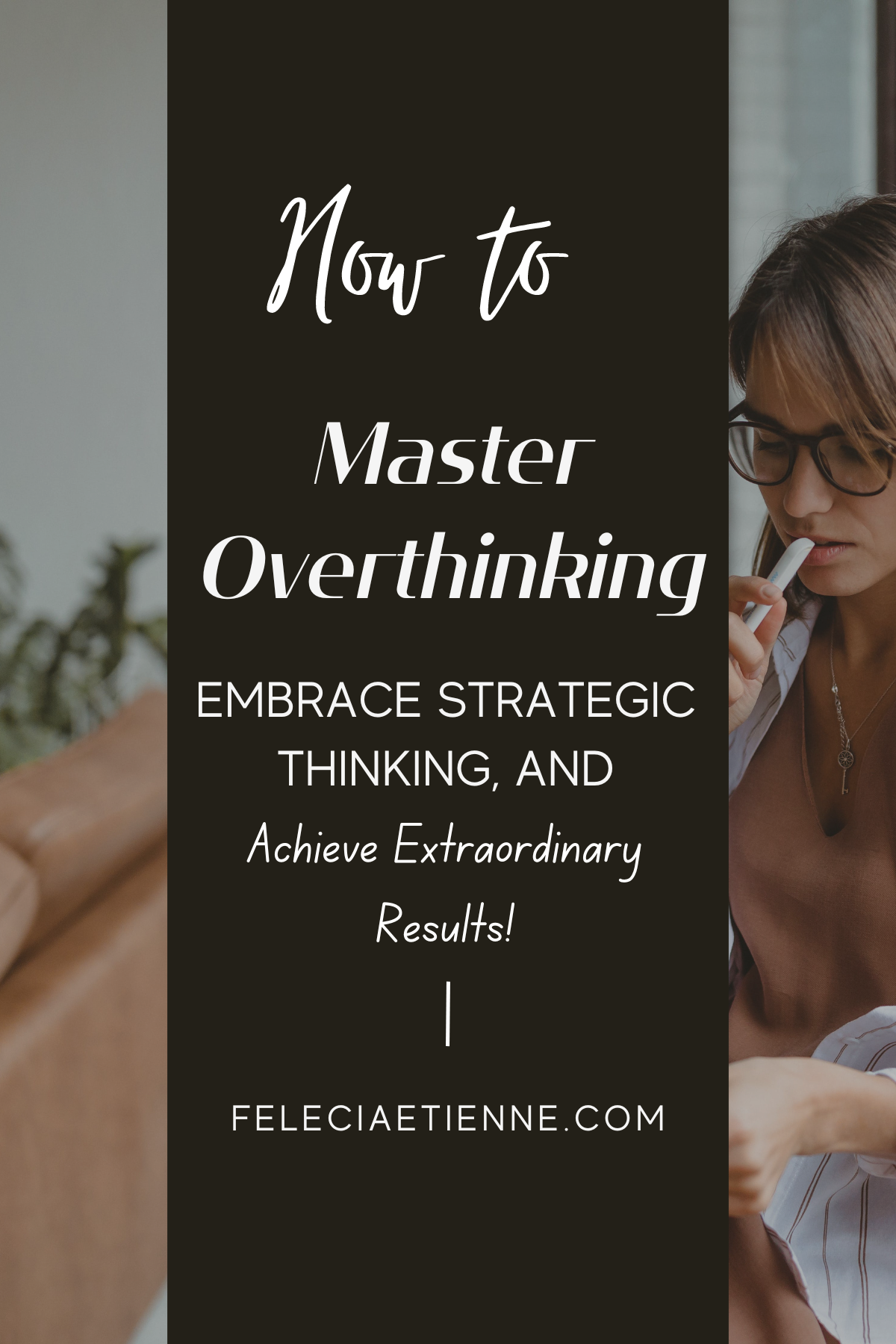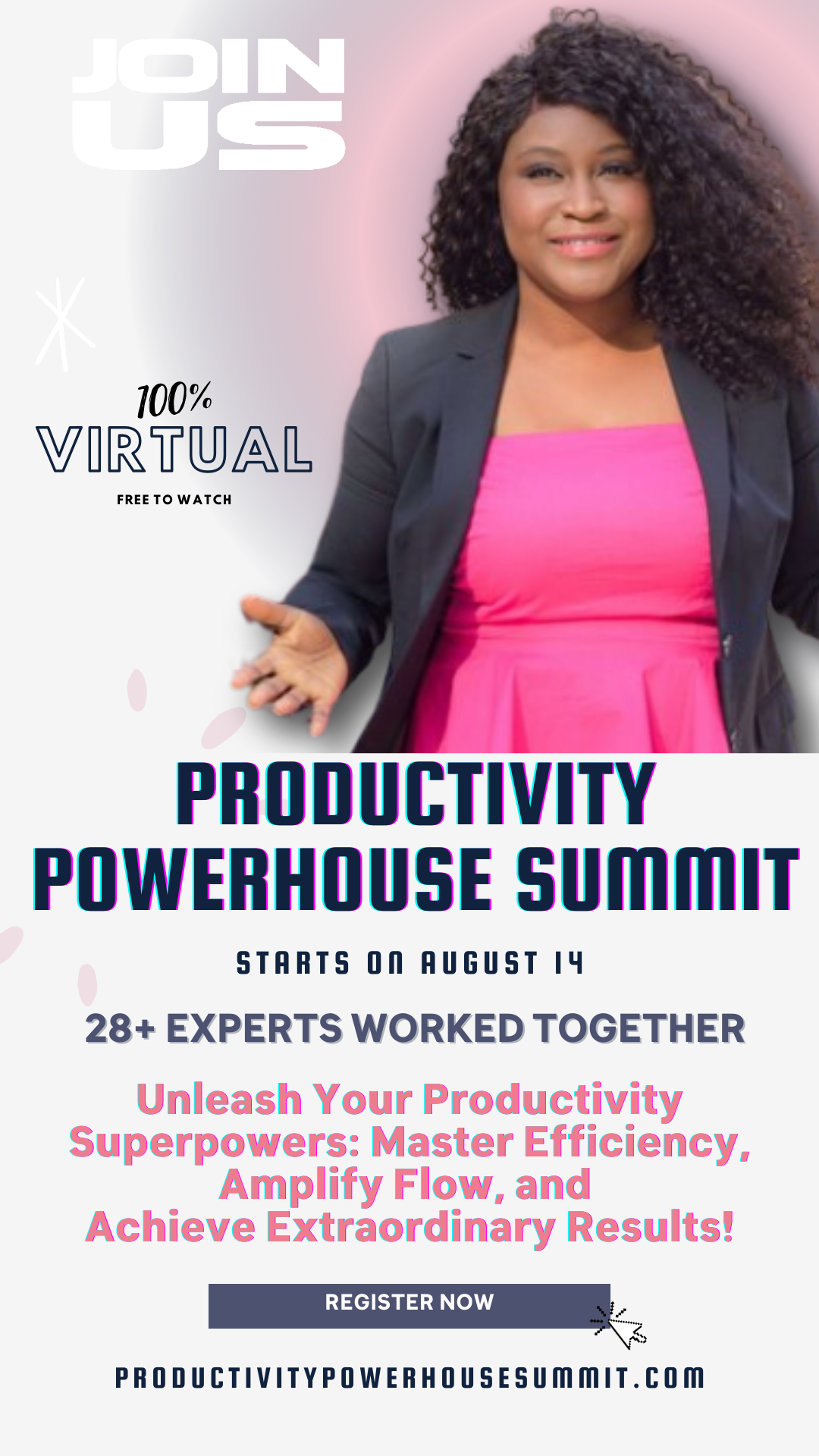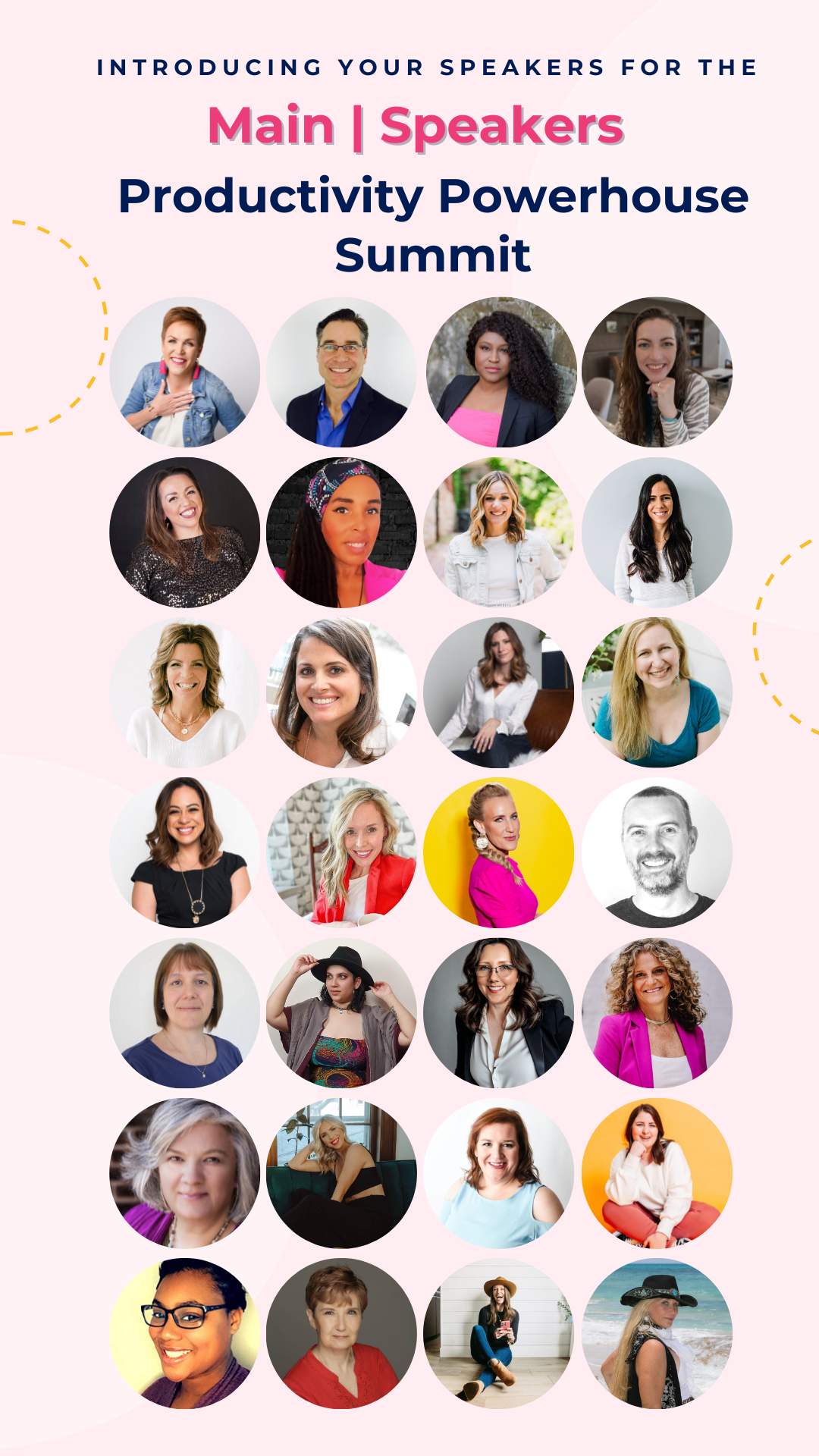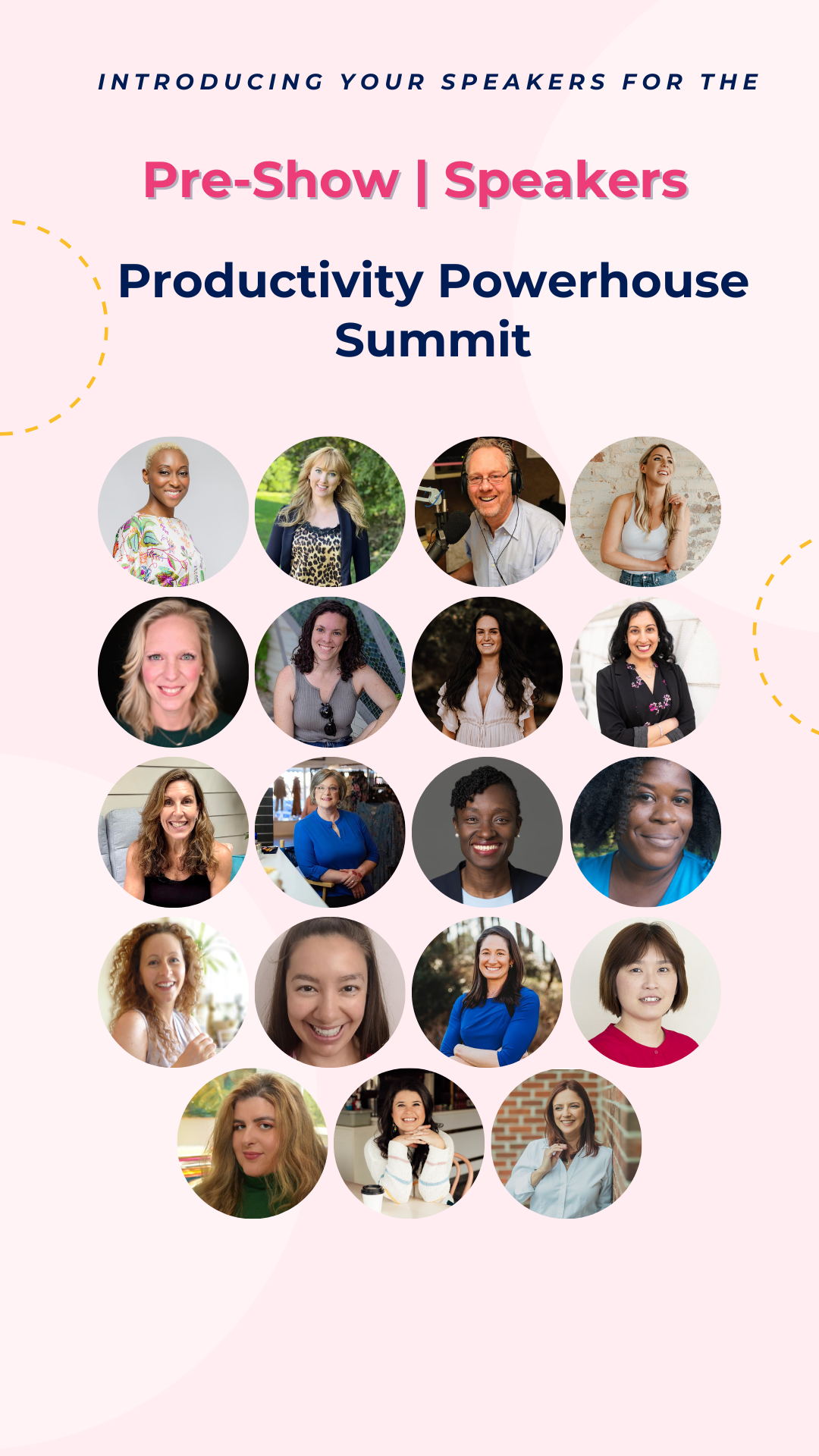HOW TO MASTER OVERTHINKING, EMBRACE STRATEGIC THINKING AND ACHIEVE EXTRAORDINARY RESULTS!
How to Master Overthinking, Embrace Strategic Thinking, And Achieve Extraordinary Results!
Are you ready to take your life, career, or business to the next level? Overthinking can be a major roadblock to success. But what if you could break free from overthinking and reach your highest potential?
If we haven't met, hi, my name is Felecia! I'm a Certified High-Performance Success Coach and Business & Life Strategist! I love to help overwhelmed, stressed-out ambitious, high-achieving women maximize their time, energy, productivity, and influence so they can be present and intentional with the vital aspects of their life. I do this through proven science-backed and outcome-based high-performance strategies, routines, habits, and mindset shifts that are simple, sustainable, and fun.
In this comprehensive blog, you'll learn powerful strategies and practical advice specifically tailored for high achievers to master overthinking and maximize their success. From understanding the power of strategic thinking to implementing actionable steps, you'll be well-equipped to conquer your overthinking and unlock the path to achieving extraordinary results. So join us as we dive into this game-changing blog and help you unlock greater success in life, career, or business!
Understanding the Detrimental Impact of Overthinking
Overthinking can be extremely detrimental to your success and overall well-being. It is often a product of anxiety, worry, and fear that can take over our lives and cause us to miss out on opportunities for growth. Overthinking leads to negative thoughts, indecision, procrastination, lack of focus and clarity, dysfunctional relationships, reduced productivity, burnout, and increased stress levels. It also stops us from taking risks and limits our ability to live in the present moment, enjoy life, and pursue our passions. By understanding the impact of overthinking, we can take actionable steps to overcome this habit and reach our peak performance.
Decision Paralysis | The Pitfall of Overanalysis
“Analysis paralysis is an epidemic that cripples countless dreams and great ideas. Be swift, decisive, and always move forward!”
Making decisions is an integral part of our daily lives. Whether deciding on a career move, starting a business, or choosing a partner, it's important to take the time and thoughtfully analyze our options. But in many cases, analysis can become overanalysis. High achievers, in particular, can easily fall into the trap of overthinking and overanalyzing every decision. This can result in decision paralysis and lead to costly mistakes that could have been avoided with a well-thought-out approach.
Overanalysis is often rooted in fear of failure or making the wrong choice. And it can be particularly detrimental for those constantly striving for perfection and have a hard time letting go of the need to analyze every decision in minute detail. Decision paralysis can delay taking action on opportunities and lead to missed chances for growth, success, and progress.
Take, for example, Oprah Winfrey, a successful leader who overcame overthinking to reach her goals. Early in her career, she admits that she often decided against taking risks out of fear or apprehension. She was hesitant to take on new challenges and let the habit of overthinking prevent her from making decisions and achieving success. With practice, however, Oprah eventually learned to trust her gut and take action on opportunities that came her way. She ultimately embraced the power of strategic thinking, implemented actionable steps, and found extraordinary success in her career.
By understanding the consequences of excessive analysis and indecisiveness, you can equip yourself with the tools to make informed and timely decisions. This can help us avoid costly mistakes, maximize our potential, and achieve extraordinary results.
RELATED ARTICLE: How Do I Stop overthinking: 6 High-Impact ways
Increased Anxiety and Stress | Breaking Free from the Worry Cycle
“In times of stress, the best thing we can do for each other is to listen with our ears and our hearts and to be assured that our questions are just as important as our answers.”
The habit of overthinking can be extremely detrimental to mental and physical well-being. When left unchecked, it can lead to increased levels of anxiety and stress that can interfere with our ability to make decisions, take action, and perform at our peak. This is because the act of worrying activates the body's "fight or flight" response, which triggers the release of stress hormones such as adrenaline and cortisol.
Chronic worrying can lead to an elevated level of these hormones in the bloodstream, which can take a toll on our physical and mental health.
Studies have shown that there is a strong correlation between overthinking and heightened levels of stress and anxiety. People who experience chronic worry are more likely to suffer from insomnia, exhaustion, depression, digestive problems, and other physical symptoms. This is because the body's stress response system can become overactive due to chronic worrying, leading to an increased risk of mental health issues such as anxiety and depression.
In addition, overthinking can lead to rumination - the act of repeatedly going over negative thoughts and feelings without taking any actionable steps. This endless cycle of worry can lead to increased stress and further exacerbate mental health issues. To break the worrying cycle and reclaim our sense of control over our lives, it is essential to better understand this habit and its impact on well-being. With the right strategies in place, we can master overthinking and unlock the path to greater success.
Limiting Creativity and Innovation | Embracing Fluid Thinking
“You can’t use up creativity. The more you use, the more you have.”
Creativity and innovation are essential for unlocking success in our personal lives, professional careers, or businesses. However, overthinking can be a significant roadblock to creative problem-solving and limit our potential for true innovation. This is because overly analytical thinking leads us down a narrow path and restricts our ability to explore solutions from different angles. High achievers, in particular, can become stuck in the trap of overthinking and miss out on chances to come up with innovative ideas or creative solutions.
For example, tennis legend Serena Williams has credited her success to believing in herself and never giving up. She believes success is achieved when you have the courage to take risks and follow your dreams. In a Stanford Graduate School of Business speech, Williams shared her life mantra: "Take chances, believe in yourself, don't be afraid to fail, and never give up". By taking an open-minded approach to problem-solving and having the courage to take risks, Williams has unlocked her full potential and achieved extraordinary success.
High-achieving women leaders can also benefit from this approach. By leaving the habit of overthinking behind, embrace fluid thinking and unlock your full potential for creative problem-solving and innovation. This could be just what's needed to take you to the next level in your career or business. With the right strategies in place, overthinking can become a thing of the past and pave the way to success.
Unleashing the Power of Strategic Thinking
Identifying the Root Cause: Reflecting on Personal Triggers
“Strategic autonomy is not secured by merely asserting one’s independence: it is secured by creating mutually beneficial interdependencies.”
Often, the habit of overthinking is rooted in deeper issues such as a fear of making mistakes, a need for perfectionism, or even unresolved childhood traumas. As high achievers, it is essential to become aware of our triggers and recognize when we are engaging in unhealthy patterns of thought.
When faced with challenging decisions or difficult tasks, taking a step back and reflecting on the underlying causes of overthinking is helpful. By engaging in introspection, you can gain insight into your thought processes and identify any recurring triggers that cause you to become stuck in analysis paralysis.
Engaging in activities such as journaling, meditation, or talking with a trusted friend can be extremely beneficial when identifying the root cause of overthinking.
Here are some prompts and self-reflection questions that can help you pinpoint the underlying causes of your overthinking and move you to action:
“With a heart filled with gratitude, we discover the extraordinary in the ordinary, find solace in the smallest blessings, and radiate appreciation for the beauty that surrounds us.”
1) When do I find myself getting stuck in overthinking?
2) What are my biggest fears when making decisions or taking action?
3) Are there any unresolved issues or traumatic moments from my past that could contribute to this thought pattern?
By reflecting on your triggers, you can better understand the causes of your overthinking and gain a better sense of control. This can help you take actionable steps to break free from the worrying cycle and unlock your potential for success.
Distinguishing Analysis from Overanalysis
Strategic Decision-Making
“It is in your moments of decision that your destiny is shaped.”
Making strategic decisions with confidence can be a daunting task for high-achievers. On the one hand, analyzing our options and making informed decisions is essential. On the other hand, we must avoid getting stuck in overanalysis and find a balance between both extremes. To help us stay on track, it is helpful to understand the difference between healthy analysis and ineffective overanalysis.
Analysis is an essential tool for high achievers, enabling us to weigh the pros and cons of different options before making decisions. This enables us to make meaningful progress and set ourselves up for success without becoming overwhelmed or stuck in analysis paralysis. Healthy analysis requires taking a step back and understanding the bigger picture while at the same time staying focused on the end goal.
Overanalysis is an unproductive and unhealthy habit that can lead to rumination and prevent us from taking action. It involves obsessing over every little detail without regard for the bigger picture or practical implementation. To distinguish between analysis and overanalysis, it is crucial to create a framework for decision-making that emphasizes the efficiency of our thought process and considers the entire scope of our goals.
By understanding the nuances between analysis and overanalysis, high-achievers can make decisions more confidently and clearly. This can help us achieve greater success in our personal lives and professional pursuits. With a mindful approach to decision-making, you can stay focused on the bigger picture while making progress toward your goal without getting stuck in rumination.
RELATED ARTICLE: How To Make a Big, Terrifying Decision as a female entrepreneur and leader
Cultivating Mindfulness in Action: The High-Performance Mindset
“With mindfulness, you can establish yourself in the present in order to touch the wonders of life that are available in that moment.”
Mindfulness is an essential practice for high-achievers, enabling us to stay focused and perform at our peak in challenging situations. Mindfulness encompasses a variety of practices, such as meditation, reflection, and journaling, which help cultivate self-awareness and enable us to make thoughtful decisions with more confidence. Introducing mindfulness into your daily lives allows you to become more aware of your thought patterns and gain the clarity necessary to break free from overthinking.
Mindfulness has been proven to enhance focus, clarity, and decision-making abilities in high-pressure situations. Studies have also shown that mindfulness is associated with increased resilience and decreases in stress levels. This enables us to maintain a positive attitude and remain calm in challenging circumstances, even when faced with difficult decisions.
Integrating mindfulness into daily life can also help you cultivate the high-performance mindset necessary for long-term success. This involves developing habits such as goal-setting, mindful decision-making, and effective communication. By mastering these skills and maintaining a positive attitude, you set yourself up to succeed beyond standard norms while maintaining positive well-being and relationships.
Empowering Your Inner Dialogue for Success
Harnessing Positive Self-Talk: Rewiring Limiting Beliefs
“Speak kindly to yourself and unleash your limitless potential.”
High achievers face a unique challenge when it comes to their internal dialogue—we are often so goal-oriented and focused on success that we may inadvertently create damaging narratives about ourselves, holding us back from achieving our dreams. This type of negative self-talk can be incredibly destructive to our well-being and performance, leading to feelings of self-doubt, anxiety, and exhaustion. But with the right strategies, we can take control of our inner dialogue and reclaim positive affirmations about ourselves and our capabilities.
One practical technique for establishing a more positive internal narrative is reframing limiting beliefs. This means shifting your perspective from pessimism to optimism and acknowledging the potential for growth within yourself. When faced with negative thoughts or doubts, take a proactive approach and actively challenge them.
Ask yourself questions like:
1) "What's the evidence that this belief is true?" or
2) "How can I reframe this thought into something more positive?"
The goal is to create a more balanced thought pattern that takes on the challenge of negative thoughts head-on and turns them into empowering affirmations.
Another powerful tool for cultivating a positive internal dialogue is to use positive affirmations. Take time each day to remind yourself of your worth and capabilities, such as "I am capable" or "I have what it takes to succeed." These affirmations can become a powerful tool in combatting negative thoughts and establishing self-confidence.
By reframing limiting beliefs and embracing positive affirmations, high achievers can take control of their inner dialogue and put themselves on a path to success. With the right tools in place, you can reach your full potential and achieve the life that you desire.
Embracing Self-Compassion | Nurturing Growth Mindset
“Embrace the beauty of self-compassion, for it is a transformative gift that allows us to nurture our hearts and souls with kindness, acceptance, and love.”
As high achievers, we often wear many hats and take on a lot of responsibility. We strive to excel and become the best version of ourselves. Despite our best efforts, sometimes overthinking can get in the way of success. One key factor that can help us break through these mental barriers is developing self-compassion. Self-compassion helps us accept ourselves for our strengths and weaknesses, embrace change, be resilient in the face of failure, and cultivate a growth-oriented mindset.
We can start cultivating self-compassion by reminding ourselves that we are not alone. We all experience difficult moments and setbacks as part of life's journey. To move forward confidently, it is essential to recognize these feelings and experiences, accept them, and take the time to process them. This can help us develop perspective and a greater appreciation for our lives as we move forward.
We can also practice self-compassion through mindful exercises. Taking regular breaks throughout the day to check in with ourselves or engaging in activities like meditation, yoga, or journaling can help ground us and center us in the present moment. Additionally, focusing on gratitude for our successes and victories can help us reflect on how far we have come and remind ourselves that even if we don't get it right the first time, we will still be okay.
Embracing self-compassion is an important step in overcoming overthinking as a high achiever.
Fueling High Performance Through Strategic Habits
The Role of Physical Exercise: Energizing the Mind
“Physical fitness is not only one of the most important keys to a healthy body, it is the basis of dynamic and creative intellectual activity.”
For high achievers, the demands of busy schedules and rigorous goals can take a toll on our mental and physical energy. One powerful way to counteract this exhaustion is through exercise. Studies have shown that physical activity boosts overall health and improves focus, memory, and cognitive function. Regular exercise releases endorphins in the brain, increasing alertness and concentration while reducing stress levels.
In addition, physical activity can help to create a positive mindset and strengthen motivation. By establishing an exercise routine that fits your daily life, you can actively cultivate a high-performance attitude and foster resilience in the face of challenges. This will help you stay energized throughout your days and remain motivated toward achieving your goals.
So how can high achievers create a regular exercise routine that works for them? A great way to start is by finding an activity that you enjoy and dedicating thirty minutes each day towards it.
This could be anything from strength training, yoga, running, or swimming. But don't underestimate the importance of rest days—it's also important to take the time to relax and focus on self-care. Try setting aside two days a week for active rest, such as walking outdoors or stretching in your living room.
By incorporating physical activity into our lives, we can fuel our performance and create sustainable habits for success. With this powerful strategy, high achievers can rise to the challenge of achieving their goals and thriving.
Optimizing Productivity: Prioritization and Focus Techniques
“My goal is no longer to get more done, but rather to have less to do.”
High achievers often face the challenge of managing their time and energy to prioritize tasks and stay focused. The most effective approach is to focus on what matters, break down larger goals into smaller achievable steps, and create systems supporting those goals. By focusing on the few critical tasks that will impact your progress, you can maximize your productivity and move closer to your goals.
One tool that can help us prioritize tasks is the Eisenhower Matrix. Developed by President Dwight Eisenhower, this strategic approach categorizes tasks into four quadrants: important and urgent, important but not urgent, not important but urgent, and neither important nor urgent. This helps us prioritize tasks based on their urgency and importance for efficient decision-making. Another tool to help you prioritize is the "Pomodoro Technique". It involves breaking down work into 25-minute increments separated by 5-minute breaks. "Pomodoro" helps you stay focused while allowing time for rest and recovery throughout the day.
By leveraging these tools and techniques, you can manage your time more effectively and prioritize the most critical tasks for your success. With the right strategies, high achievers can reach high performance and achieve their goals.
Building a Support Network: Leveraging Relationships for Success
“Choose to focus your time, energy and conversation around people who inspire you, support you and help you to grow you into your happiest, strongest, wisest self.”
Having a solid support network is instrumental to success for high achievers. While it can be easy to get caught up in the hustle and bustle of everyday life, surrounding ourselves with individuals who understand our goals and cheer us on is essential for progress. These relationships can provide guidance, accountability, and assurance that we are moving toward our objectives.
One of the most impactful ways to build a support network is through working with a certified high-performance coach. Certified High-Performance Coaching (CHPC) is different from other forms of coaching in that it allows you to succeed in all areas of your life while maintaining balance and sustaining vital relationships. The 12-module framework focuses on improving clarity, energy, courage, productivity, influence, purpose, and more to increase your overall performance. CHPC has achieved an impressive overall client satisfaction of 9.7/10 with a scientifically-backed challenge-based curriculum designed to yield clear outcomes.
Additionally, seeking mentorship can be incredibly beneficial for high achievers looking to further their success. Mentorship relationships offer valuable insights and guidance and a unique opportunity to collaborate and network. By connecting with those who have succeeded in the areas we are striving for, we can learn from their experiences and gain valuable knowledge to help propel our progress.
Finally, establishing accountability within our support network is crucial for achieving success. Having an individual or team who holds us responsible and encourages us to remain on track can help us stay focused and motivated in the face of challenges. To ensure continual progress, it is important to set goals and objectives, seek feedback, measure success, make adjustments as needed, and celebrate wins.
Bottom-line:
As high achievers, we all have the potential to reach our highest performance and achieve success. By incorporating physical activity into your routines, optimizing productivity through prioritization techniques, and building a strong support network with mentorship and accountability, we can create lasting habits for success that will help us stay motivated and propel us toward reaching our goals. If you're ready to take your performance to the next level and experience success, schedule a call with me today for a high-performance strategy session. Together, we can create a plan of action designed specifically for you to help you reach peak performance and thrive.


















